

George Grosz
1893 - 1959
George Grosz was a German artist known especially for his caricatural drawings and paintings of Berlin life in the 1920s. He was a prominent member of the Berlin Dada and New Objectivity groups during the Weimar Republic. He emigrated to the United States in 1933, and became a naturalized citizen in 1938. Abandoning the style and subject matter of his earlier work, he exhibited regularly and taught for many years at the Art Students League of New York. In 1959 he returned to Berlin, where he died shortly afterwards.
Work
Although Grosz made his first oil paintings in 1912 while still a student,
his earliest oils that can be identified date from 1916.
By 1914, Grosz worked in a style influenced by Expressionism and Futurism, as well as by popular illustration, graffiti, and children's drawings. Sharply outlined forms are often treated as if transparent. The City (1916-17) was the first of his many paintings of the modern urban scene. Other examples include the apocalyptic Explosion (1917), Metropolis (1917), and The Funeral, a 1918 painting depicting a mad funeral procession. He settled in Berlin in 1918 and was a founder of the Berlin Dada movement, using his satirical drawings to attack bourgeois supporters of the Weimar Republic.
His drawings, usually in pen and ink which he sometimes developed further with watercolor, frequently included images of Berlin and the Weimar Republic in the 1920s. Corpulent businessmen, wounded soldiers, prostitutes, sex crimes and orgies were his great subjects (for example, see Fit for Active Service). His draftsmanship was excellent although the works for which he is best known adopt a deliberately crude form of caricature in the style of Jugend. His oeuvre includes a few absurdist works, such as Remember Uncle August the Unhappy Inventor which has buttons sewn on it, and also includes a number of erotic artworks.
After his emigration to the USA in 1933, Grosz "sharply rejected [his] previous work, and caricature in general." In place of his earlier corrosive vision of the city, he now painted conventional nudes and many landscape watercolors. More acerbic works, such as Cain, or Hitler in Hell (1944), were the exception. In his autobiography, he wrote: "A great deal that had become frozen within me in Germany melted here in America and I rediscovered my old yearning for painting. I carefully and deliberately destroyed a part of my past." Although a softening of his style had been apparent since the late 1920s, Grosz's work assumed a more sentimental tone in America, a change generally seen as a decline. His late work never achieved the critical success of his Berlin years.
In 1968, the Heckscher Museum of Art in Huntington purchased the painting Eclipse of the Sun for $15,000.00, raising the money by public subscription. As it portrays the warmongering of arms manufacturers, this painting became a destination of protesters of the Vietnam War in Heckscher Park (where the museum is sited) in the late 1960s and early 70s.
In 2006, the Heckscher proposed selling Eclipse of the Sun at its then-current appraisal of approximately $19,000,000.00 to pay for repairs and renovations to the building. There was such public outcry that the museum decided not to sell, and announced plans to create a dedicated space for display of the painting in the renovated museum.
Text courtesy of Wikipedia, 2025


![The End of a Perfect Day [Nach getaner Arbeit]](https://img.smartify.org/d7HI6Y5g-RCKlDACyzeG1gWSpkFrvNUVh-MdlJszUKw/resize:fill:800:800:0:0/gravity:fp:0.5:0.5/format:jpg/czM6Ly9zbWFydGlmeS1tZWRpYS9hcnR3b3JrLWltYWdlL05HQV8yMDE1XzE5XzI0ODEvbWVkaWFfQ3RlTWh4WkxSMXBLZnJCUExBdFdoRi5qcGc.jpg?Policy=eyJTdGF0ZW1lbnQiOiBbeyJSZXNvdXJjZSI6Imh0dHBzOi8vaW1nLnNtYXJ0aWZ5Lm9yZy9kN0hJNlk1Zy1SQ0tsREFDeXplRzFnV1Nwa0Zydk5VVmgtTWRsSnN6VUt3L3Jlc2l6ZTpmaWxsOjgwMDo4MDA6MDowL2dyYXZpdHk6ZnA6MC41OjAuNS9mb3JtYXQ6anBnL2N6TTZMeTl6YldGeWRHbG1lUzF0WldScFlTOWhjblIzYjNKckxXbHRZV2RsTDA1SFFWOHlNREUxWHpFNVh6STBPREV2YldWa2FXRmZRM1JsVFdoNFdreFNNWEJMWm5KQ1VFeEJkRmRvUmk1cWNHYy5qcGciLCJDb25kaXRpb24iOnsiRGF0ZUxlc3NUaGFuIjp7IkFXUzpFcG9jaFRpbWUiOjE3NjQ4MDY0MDB9LCJEYXRlR3JlYXRlclRoYW4iOnsiQVdTOkVwb2NoVGltZSI6MTc2MzUxMDQwMH19fV19&Signature=jiTgOfmMYHLfi52j0~1vnbtzXOfhL14mH5NiIDPkGiGhWzSkGvzcmrEwv-g1izX3sqIdVmwVfXEVlWQgXuHeCa3TkCR6FbJbYNxm9FHupSLNYAPPETwSAOQ5z5GK1AOCR5mzXT1GUVzwvl3Tb674B-BscdW8SfGElNQJrQ2dYcldyojXsd1bcCDuhF-dssGpV1izUizWmvgbCqN9zVtKCEwJ42nWL~vRM~MBSrGiUNOT-8OdBd92OEKV7E0dMQuQC0LCtEPlEZRh4nSZSZ8YNGL3aCWEtTIs-bPrxvcC1uW-18~T4zC0zsPGicCzRUXw53yuNFPwACyeFiraqY9r6Q__&Key-Pair-Id=K2TK72C9H46KK2)























